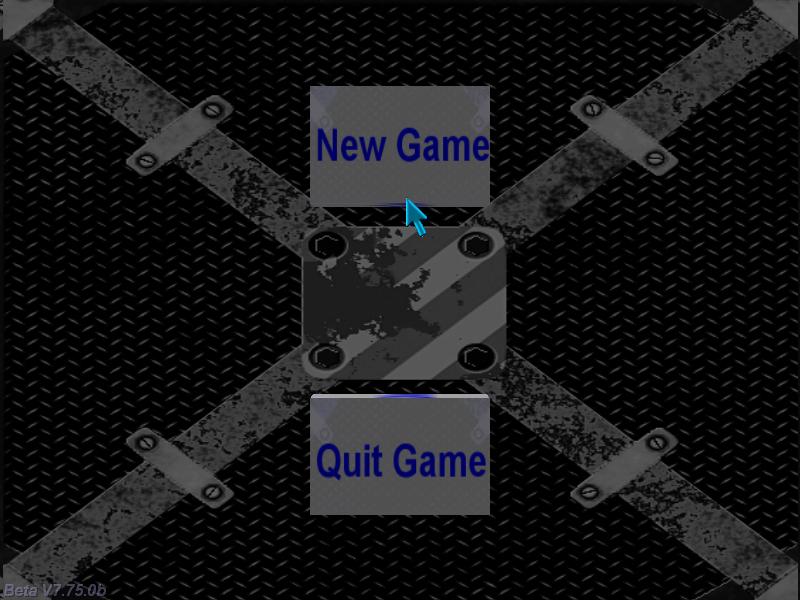Q: Is it possible to create a high precision timer for my racing game?
A: Use the snippet below:
FONT* arial_font = "Arial#20";
var hours;
var minutes;
var seconds;
var milliseconds;
function timer_startup()
{
while (1)
{
milliseconds += (timer() / 1000);
if (milliseconds > 1000)
{
milliseconds -= 1000;
seconds += 1;
}
if(seconds > 59)
{
minutes += 1;
seconds -= 60;
if(minutes >= 59)
{
hours += 1;
minutes -= 60;
}
}
wait (1);
}
}
PANEL* timer_pan =
{
layer = 15;
digits(100, 20, 2, arial_font , 1, hours);
digits(150, 20, 2, arial_font , 1, minutes);
digits(200, 20, 2, arial_font , 1, seconds);
digits(250, 20, 3, arial_font , 1, milliseconds);
flags = SHOW;
}
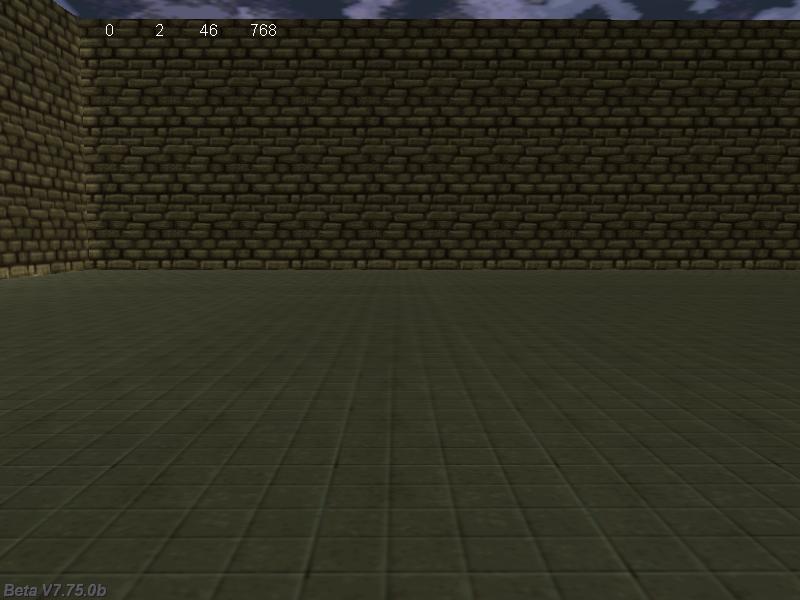
Q: Does anyone know a way to make an entity appear at a spot on the level where a user clicks?
A: Use this example:
BMAP* pointer_tga = "pointer.tga";
STRING* target_mdl = "dot.mdl";
function adjust_target()
{
my.z += 5; // play with the target entity here
}
function create_target()
{
VECTOR pos1, pos2;
pos1.x = mouse_pos.x;
pos1.y = mouse_pos.y;
pos1.z = 0;
vec_for_screen (pos1, camera);
pos2.x = mouse_pos.x;
pos2.y = mouse_pos.y;
pos2.z = 20000; // use a big value here
vec_for_screen (pos2, camera);
c_trace (pos1.x, pos2.x, IGNORE_PASSABLE); // now "target" holds the coordinates of the hit point
ent_create (target_mdl, target, adjust_target); // create the entity at the "target" position
}
function mouse_startup()
{
on_mouse_left = create_target; // create a target entity when the player presses the left mouse button
mouse_mode = 2;
mouse_map = pointer_tga;
while (1)
{
vec_set(mouse_pos, mouse_cursor);
wait(1);
}
}
Q: Is there any other way to detect entity collision other than using event_type? I'd like to track a collision only with a particular door.
A: You can use event_type to check if an entity has collided only with a particular door, just like this:
ENTITY* my_door;
action special_door() // attach this action to your door
{
my_door = my;
}
function detect_door()
{
if (you == my_door)
{
beep(); // beep twice only if the player has collided with the particular door
beep();
}
}
action players_code() // attach this action to your player
{
var movement_speed = 10; // movement speed
VECTOR temp;
set (my, INVISIBLE); // 1st person player
player = my; // I'm the player
my.emask |= (ENABLE_IMPACT | ENABLE_ENTITY);
my.event = detect_door;
while (1)
{
my.pan -= 7 * mouse_force.x * time_step;
camera.x = my.x;
camera.y = my.y;
camera.z = my.z + 50 + 1.1 * sin(my.skill44); // play with 50 and 1.1
camera.pan = my.pan;
camera.tilt += 5 * mouse_force.y * time_step;
vec_set (temp.x, my.x); // trace 10,000 quants below the player
temp.z -= 10000;
temp.z = -c_trace (my.x, temp.x, IGNORE_ME | IGNORE_PASSABLE | USE_BOX) - 2; // play with 2
temp.x = movement_speed * (key_w - key_s) * time_step;
temp.y = movement_speed * (key_a - key_d) * 0.6 * time_step;
c_move (my, temp.x, nullvector, IGNORE_PASSABLE | GLIDE);
wait (1);
}
}
Q: How can I make an entity move to the specified location?
A: Here's an example that moves an NPC character towards its goal using primitive, and yet fully functional obstacle avoidance code.
ENTITY* goal;
action npc_goal() // attach this action to the destination entity
{
goal = my;
}
action goal_tracker() // attach this action to your NPC character
{
while (!goal) {wait (1);} // wait until the goal entity is loaded
VECTOR temp, temp_angle;
var npc_speed = 5;
var covered_dist, i;
while (1)
{
my.skill10 += 6 * time_step; // 6 gives the animation speed
vec_set (temp.x, my.x); // trace 10,000 quants below the npc entity
temp.z -= 10000;
temp.z = -c_trace (my.x, temp.x, IGNORE_ME | IGNORE_PASSABLE | USE_BOX) + 20; // play with 20
temp.x = npc_speed * time_step;
temp.y = 0;
ent_animate(my, "walk", my.skill10, ANM_CYCLE);
covered_dist = c_move (my, temp.x, nullvector, IGNORE_PASSABLE | GLIDE);
if (covered_dist < 0.1) // the npc is stuck?
{
my.pan += 90 - random(180); // then add a random angle to its pan angle
i = 0;
while (i < 10) // walk in the new direction for 10 frames, play with 10
{
c_move (my, temp.x, nullvector, IGNORE_PASSABLE | GLIDE);
ent_animate(my, "walk", my.skill10, ANM_CYCLE);
i++;
wait (1);
}
}
else // the npc can move? Then rotate it towards the goal again!
{
vec_set(temp_angle, goal.x);
vec_sub(temp_angle, my.x);
vec_to_angle(my.pan, temp_angle);
my.tilt = 0;
}
if (vec_dist(goal.x, my.x) < 50) // the npc has found the goal entity?
break; // then get out of the while loop!
wait (1);
}
// the goal was reached here
ent_animate(my, "stand", 0, 0); // switch to "stand"
}
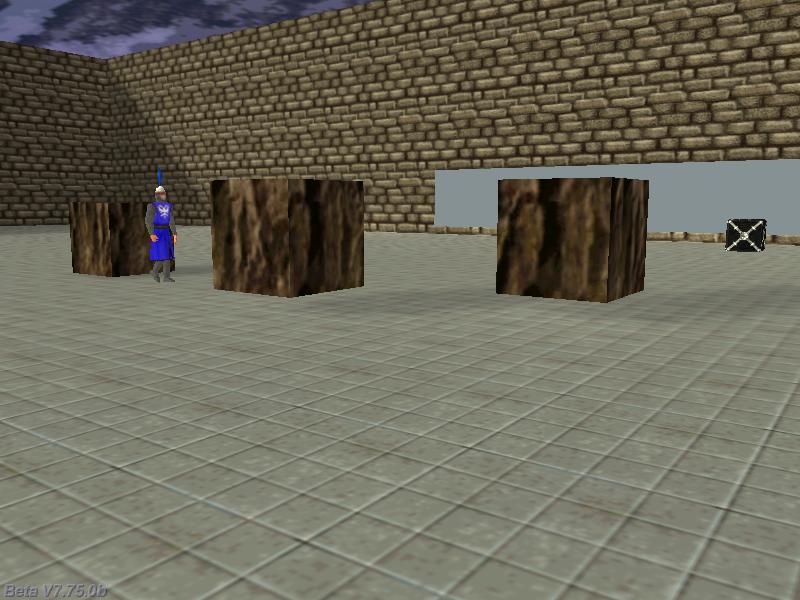
Q: I have a car model; how do I make it follow the direction of the path smoothly?
A: Here's a simplified version of the code used in my car demo.
#define car_speed skill55
SOUND* aiskids1_wav = "aiskids1.wav";
SOUND* carai1_wav = "carai1.wav";
ENTITY* dummy1;
ENTITY* carai1_dummy;
ENTITY* carai1;
action car_ai()
{
carai1 = my;
var distance = 0;
var previous_pan;
var following_pan;
var min_speed = 20;
var max_speed;
var carai_engine;
var engine_factor;
var dist_z;
var skids_once = 0;
VECTOR last_pos[3];
VECTOR direction[3];
VECTOR temp[3];
max_speed = 35;
dummy1 = ent_create(NULL, nullvector, NULL);
// create another (carai1_dummy) dummy entity that will move on the path
// the ai car will use the same x, y, pan, tilt and roll with the carai1_dummy entity that moves on the path
// but will compute its own z using c_trace; this way, the nodes don't have to be place precisely above the ground
carai1_dummy = ent_create(NULL, nullvector, NULL);
path_set(dummy1, "path_001"); // make sure to name your path this way
engine_factor = 2 + random(2); // start with a random engine sound frecquency each and every time
carai_engine = ent_playloop(carai1, carai1_wav, 300); // start playing the car ai engine sound in a loop
while(1)
{
previous_pan = carai1.pan;
// place the carai1 entity on the path
path_spline(dummy1, carai1_dummy.x, distance);
distance += dummy1.car_speed * time_step;
// let carai1 look ahead
vec_diff(direction, carai1_dummy.x, last_pos);
vec_to_angle(carai1_dummy.pan, direction);
vec_set(last_pos, carai1_dummy.x);
carai1.pan = carai1_dummy.pan;
carai1.tilt = carai1_dummy.tilt;
carai1.roll = carai1_dummy.roll;
carai1.x = carai1_dummy.x;
carai1.y = carai1_dummy.y;
vec_set (temp.x, carai1_dummy.x);
temp.z -= 2000;
dist_z = c_trace(carai1_dummy.x, temp.x, IGNORE_ME | IGNORE_PASSABLE | IGNORE_MODELS); // ignore the "real" carai
carai1.z = carai1_dummy.z - dist_z + 35; // 35 = experimental value
// sets a variable car ai engine frequency, depending on the speed of the car
snd_tune(carai_engine, 0, dummy1.car_speed * engine_factor, 0);
wait(1);
following_pan = carai1.pan;
if (abs(following_pan - previous_pan) > 1) // sudden direction change? Then lower the speed of the AI car
{
dummy1.car_speed -= 4 * time_step;
if (skids_once == 0)
{
skids_once = 1;
if (random(1) > 0.9)
{
ent_playsound(dummy1, aiskids1_wav, 3000);
}
}
}
else
{
skids_once = 0;
dummy1.car_speed += 2 * time_step;
}
dummy1.car_speed = clamp(dummy1.car_speed, min_speed, max_speed);
}
}
Q: How can I make a bitmap stay full screen, regardless of the screen resolution?
A: Use this snippet:
BMAP* splash_tga = "splash.tga"; // splash screen bitmap
PANEL* splash_pan =
{
bmap = splash_tga;
layer = 15;
flags = SHOW;
}
// makes the panel fill the entire screen, regardless of the screen size and / or the bitmap resolution
function panel_startup()
{
while (1)
{
splash_pan.scale_x = screen_size.x / bmap_width(splash_tga);
splash_pan.scale_y = screen_size.y / bmap_height(splash_tga);
wait (1);
}
}
Q: I wonder if it is possible to make an installer of the game I created. How can I do that?
A: There are several free installers that get the job done; here's how Inno Setup from http://www.jrsoftware.org/ works:
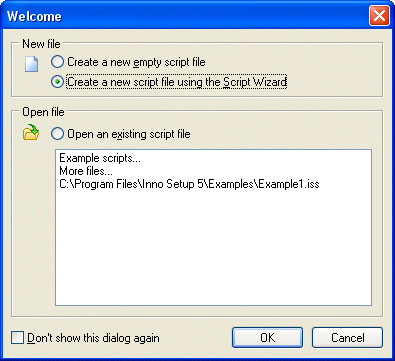
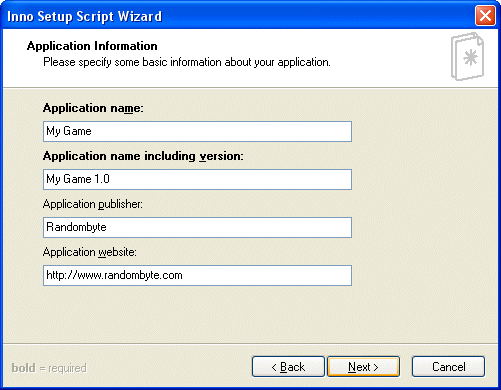
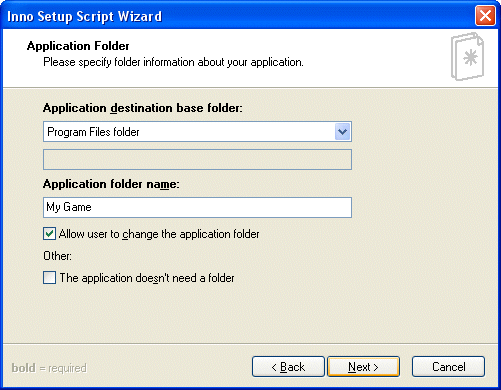
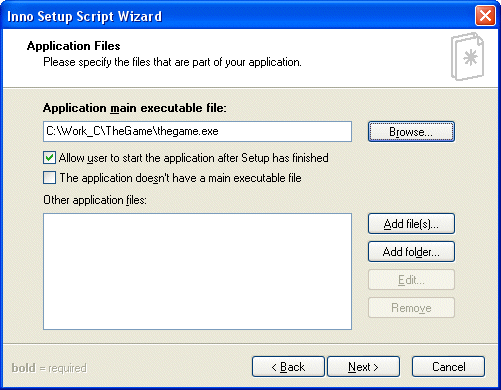
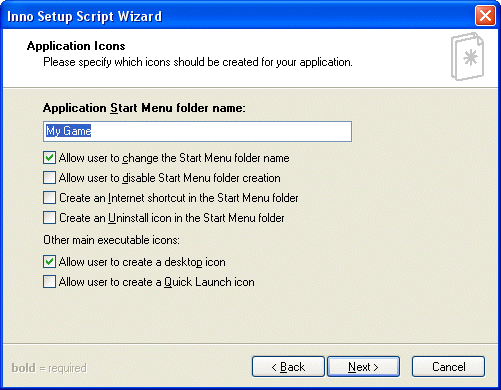
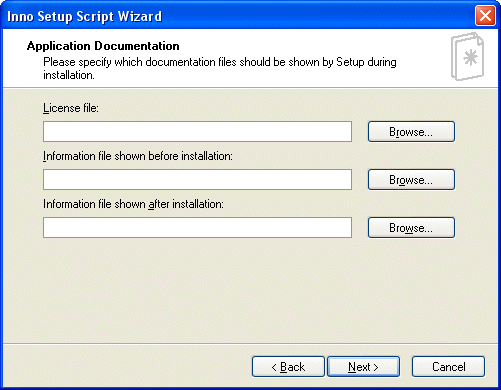
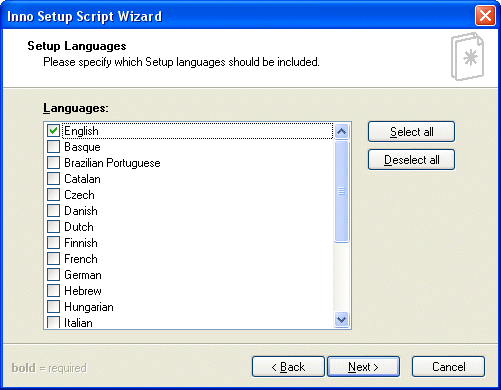
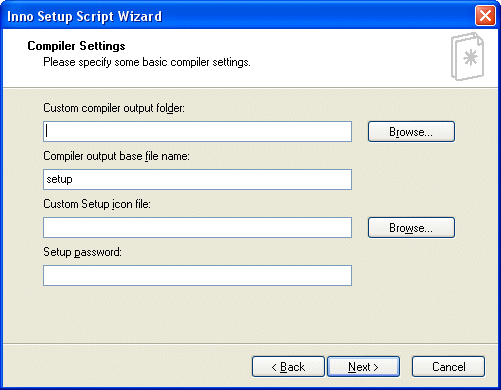
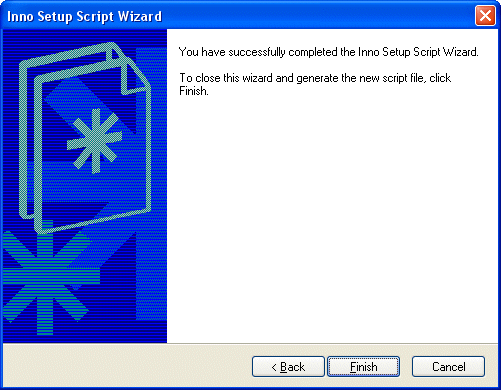
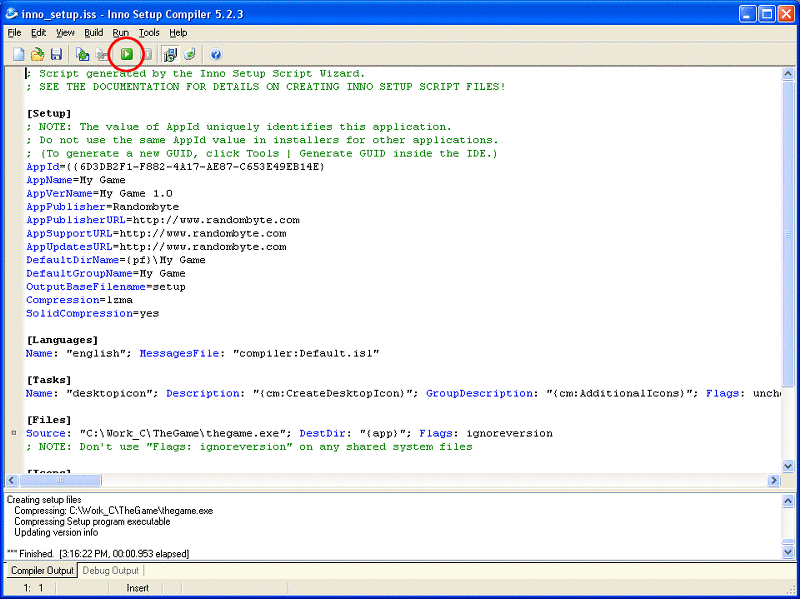
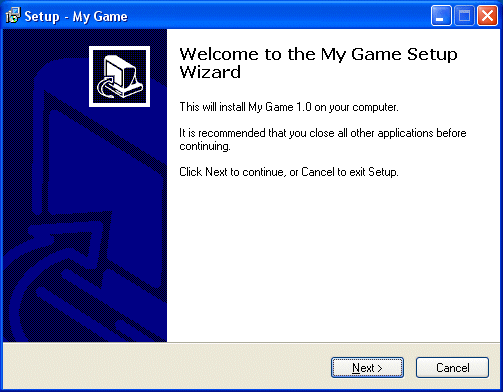
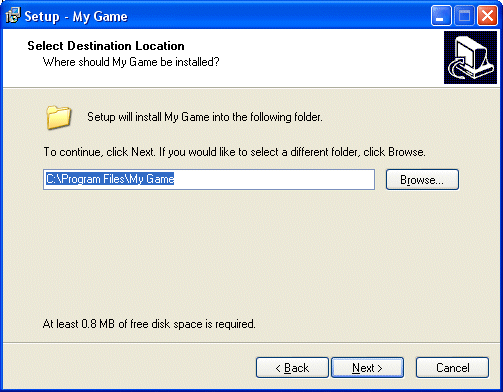
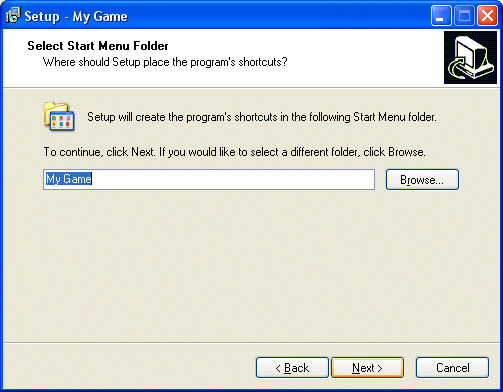
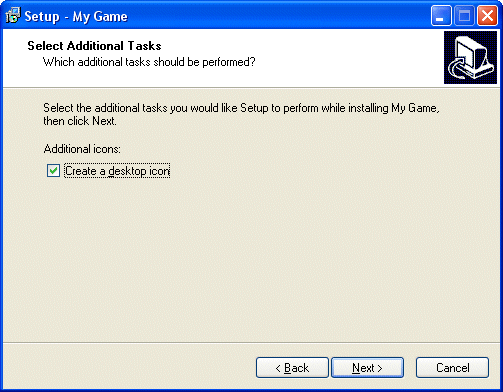
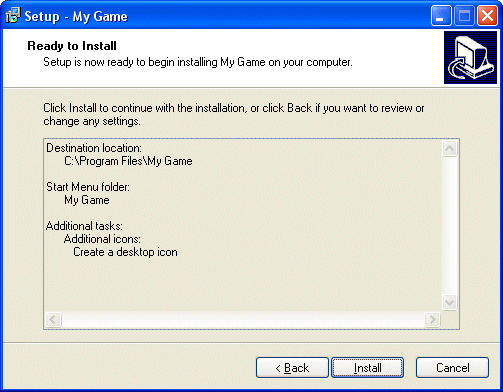
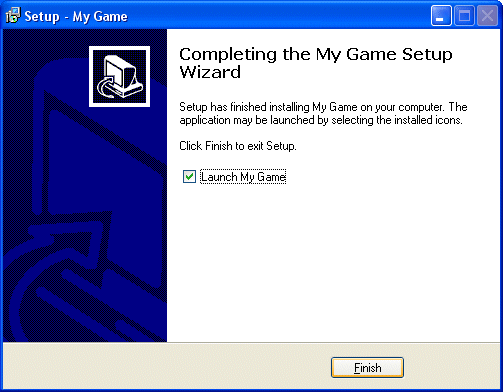
Q: I want to have a light moving on a path. How can I do that?
A: Use this snippet:
var entity_speed = 3;
var movement_enabled = 0;
var dist_to_node;
var current_node = 1;
VECTOR temp_angle;
VECTOR pos_node; // stores the position of the node
function move_target()
{
while(1)
{
if(movement_enabled)
{
entity_speed = minv(5, entity_speed + 0.5 * time_step);
c_move(my, vector(entity_speed * time_step, 0, 0), nullvector, IGNORE_PASSABLE | GLIDE);
vec_to_angle (my.pan, vec_diff (temp_angle, pos_node, my.x));
}
wait(1);
}
}
action light_follows_path() // attach this action to your light model
{
// set (my, INVISIBLE | PASSABLE); // if you don't want the light to be visible
vec_set(my.blue, vector(255, 255, 255)); // set a white color for the light
my.lightrange = 300; // and a range of 300 quants
move_target();
result = path_scan(me, my.x, my.pan, vector(360, 0, 500)); // scan the area
if (result) {movement_enabled = 1;}
path_getnode (my, 1, pos_node, NULL);
vec_to_angle (my.pan, vec_diff (temp_angle, pos_node, my.x)); // rotate towards the node
while(1)
{
dist_to_node = vec_dist(my.x, pos_node);
if(dist_to_node < 50) // close to the node?
{
current_node = path_nextnode(my, current_node, 1);
if (!current_node) {current_node = 1;} // reached the end of the path? Then start over!
path_getnode (my, current_node, pos_node, NULL);
}
wait(1);
}
}
Q: I'm looking for a jump-pad snippet like in Quake.
A: There you go:
SOUND* jump_wav = "jump.wav";
function jump_now()
{
snd_play(jump_wav, 80, 0);
my.event = NULL; // don't trigger several jumps at once
var vertical_force = 100; // play with 100
while(vertical_force > 1) //while we have some jump force left
{
if (player) // we are controlling the player?
{
c_move(player, vector(0, 0, vertical_force * time_step), nullvector, 0);
}
vertical_force -= 2.5 * time_step; // play with 2.5
wait(1);
}
my.event = jump_now; // allow the jumps again
}
action jumping_pad() // attach this action to your jump pad model / wmb entity
{
my.emask |= (ENABLE_IMPACT | ENABLE_ENTITY);
my.event = jump_now;
}
action players_code() // need special player code as well
{
var movement_speed = 10; // movement speed
VECTOR temp;
set (my, INVISIBLE); // 1st person player
player = my; // I'm the player
while (1)
{
my.pan -= 7 * mouse_force.x * time_step;
camera.x = my.x;
camera.y = my.y;
camera.z = my.z + 50 + 1.1 * sin(my.skill44); // play with 50 and 1.1
camera.pan = my.pan;
camera.tilt += 5 * mouse_force.y * time_step;
temp.x = movement_speed * (key_w - key_s) * time_step;
temp.y = movement_speed * (key_a - key_d) * 0.6 * time_step;
temp.z = -15 * time_step;
c_move (my, temp.x, nullvector, IGNORE_PASSABLE | GLIDE);
wait (1);
}
}
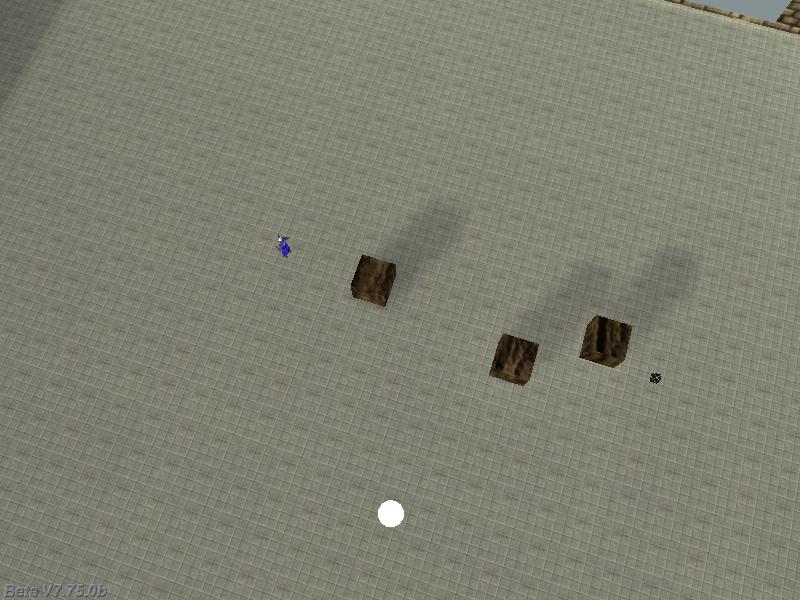
Q: How can I create a 3D menu, with 3D buttons that can be clicked?
A: Use this example as a base for your code:
BMAP* pointer_tga = "pointer.tga";
function mouse_startup()
{
mouse_mode = 2;
mouse_map = pointer_tga;
while (1)
{
vec_set(mouse_pos, mouse_cursor);
wait(1);
}
}
function start_game()
{
printf("Starts a new game");
}
function new_game()
{
my.emask |= ENABLE_CLICK;
my.event = start_game;
}
function end_game()
{
sys_exit (NULL); // shut down the engine
}
function quit_game()
{
my.emask |= ENABLE_CLICK;
my.event = end_game;
}
function main()
{
vec_set(screen_color, vector(200, 0, 0)); // make the background color blue
fps_max = 70;
video_mode = 7; // run in 800x600 pixels
video_depth = 32; // 32 bit mode
level_load (NULL); // load an empty level
wait (2); // wait a bit
camera.pan = 90; // point the camera in the right direction
ent_create("background.mdl", vector (0, 200, 0), NULL); // create the background model
ent_create("newgame.mdl", vector (0, 135, 30), new_game); // create the "New game" model
ent_create("quitgame.mdl", vector (0, 135, -30), quit_game); // create the "Quit game" model
}
